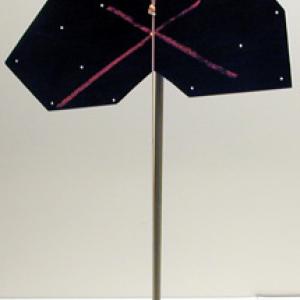College of Liberal Arts & Sciences
1J10.12 - Wooden Plates
Place the wooden plate on the screwdriver hanger. Hang the plumb bob from the hanger also. Draw straight lines down the plumb bob, then hang the wooden plate from one of the different holes and draw another line. After this is done two or three times the lines should intersect at a point. This should be the center of mass of the object.
- Francisco Jose Torcal-Milla, "Video-Aided Observation of the Center of Mass of Plane Objects", TPT, Vol. 62, #1, Jan. 2024, p. 12.
- Charles J. Reidl, Jr., "Three Methods of Finding Center of Mass", TPT, Vol. 33, # 2, p. 126-127, Feb. 1995.
- James Casey, "Exploring Properties of Forces in Equilibrium", TPT, Vol. 32, # 6, Sept. 1994, p. 364.
- Thomas B. Greenslade, Jr., "Center of Mass Demonstrations Using Ceiling Tile", TPT, Vol. 30, # 4, p. 240, April 1992.
- Bill Reid, "Center of Mass of a "State"", TPT, Vol. 27, # 6, Sept. 1989, p. 460.
- R. D. Edge, "Center of Mass", TPT, Vol. 22, # 8, Nov. 1984, p. 535 - 537.
- Adel Alameh, "Static Equilibrium in a Uniform Gravitational Field", TPT, Vol. 61, #4, Apr. 2023, p. 298.
- Jose M. Campillo-Robles, Ibon Alonso, Ane Gondra, Nerea Gondra, "Calculation and Measurement of Center of Mass: An All-In-One Activity Using Tangram Puzzles", AJP, Vol. 90, #9, Sept. 2022, p. 652.
- Albert A. Bartlett, Richard L. Conlkin, "U.S. Population Dynamics", AJP, 53, # 3, March 1985.
- M- 466: "Virginia & Other Irreg. Shapes", DICK and RAE Physics Demo Notebook.
- M- 32: Richard Manliffe Sutton, Demonstration Experiments in Physics.
- R. W. Pohl, "The Rotation of Rigid Bodies", Physical Principles of Mechanics and Acoustics, p. 97.
- Guenter Schwarz, "Center of Mass", Apparatus Notes, July 1965-December 1972, p. 56.
- Charles Vivian, "Finding the Center of Gravity", Science Experiments & Amusements For Children, p. 12.
- David Kutliroff, "47, Center of Mass Demonstrations with a Plywood 'Amoeba'", 101 Classroom Demonstrations and Experiments For Physics Teachers, p. 105.
- Martin Gardner, "Balancing Point", Entertaining Science Experiments with Everyday Objects, p. 85.
- Borislaw Bilash II, David Maiullo, "Where's the Middle?", A Demo a Day: A Year of Physics Demonstrations, p. 148.
- Janice VanCleave, "70, Balancing Blob", Teaching the Fun of Physics, p. 109.
- Janice VanCleave, "Downward", Physics for Every Kid - 101 Easy Experiments in Motion, Heat, Light, Machines, and Sound, p. 88- 89.
- "Center of Mass of Odd Shaped Objects", Physics From the Junk Drawer, 3rd Edition, The Science House, North Carolina State University, p. 21.
- Julius Sumner Miller, "Cenco-Miller Center of Mass Demonstration", Physics fun and Demonstrationsp. p.141.
- Tik L. Liem, "Where Is The Balancing Point?", Invitations to Science Inquiry - Supplement to 1st and 2nd Ed. p. 99.
- Borislaw Bilash II, “Where's the Middle?“, A Demo A Day – A Year of Physical Science Demonstrations, p. 208.
Disclaimer: These demonstrations are provided only for illustrative use by persons affiliated with The University of Iowa and only under the direction of a trained instructor or physicist. The University of Iowa is not responsible for demonstrations performed by those using their own equipment or who choose to use this reference material for their own purpose. The demonstrations included here are within the public domain and can be found in materials contained in libraries, bookstores, and through electronic sources. Performing all or any portion of any of these demonstrations, with or without revisions not depicted here entails inherent risks. These risks include, without limitation, bodily injury (and possibly death), including risks to health that may be temporary or permanent and that may exacerbate a pre-existing medical condition; and property loss or damage. Anyone performing any part of these demonstrations, even with revisions, knowingly and voluntarily assumes all risks associated with them.
